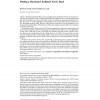1450 search results - page 27 / 290 » On the Complexity of Hardness Amplification |
ESA
2006
Springer
13 years 11 months ago
2006
Springer
A coloring is proper if each color class induces connected components of order one (where the order of a graph is its number of vertices). Here we study relaxations of proper two-c...
HPCA
2007
IEEE
14 years 8 months ago
2007
IEEE
The emergence of multicore architectures will lead to an increase in the use of multithreaded applications that are prone to synchronization bugs, such as data races. Software sol...
SAC
2008
ACM
13 years 7 months ago
2008
ACM
Model-Driven Engineering (MDE) has been advocated as an effective way to deal with today's software complexity. MDE can be seen as an integrative approach combining existing ...
FOCS
1999
IEEE
13 years 12 months ago
1999
IEEE
Various efforts ([?, ?, ?]) have been made in recent years to derandomize probabilistic algorithms using the complexity theoretic assumption that there exists a problem in E = dti...
JACM
2006
13 years 7 months ago
2006
Abstract. Maximum likelihood (ML) is an increasingly popular optimality criterion for selecting evolutionary trees [Felsenstein 1981]. Finding optimal ML trees appears to be a very...

